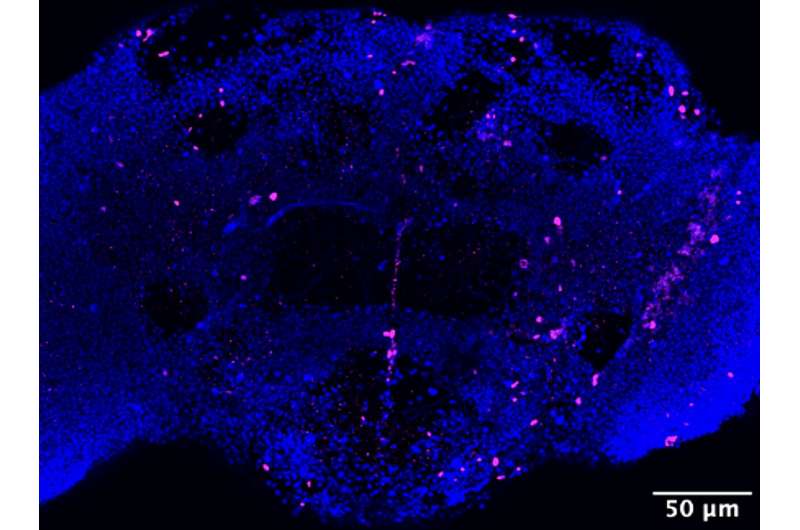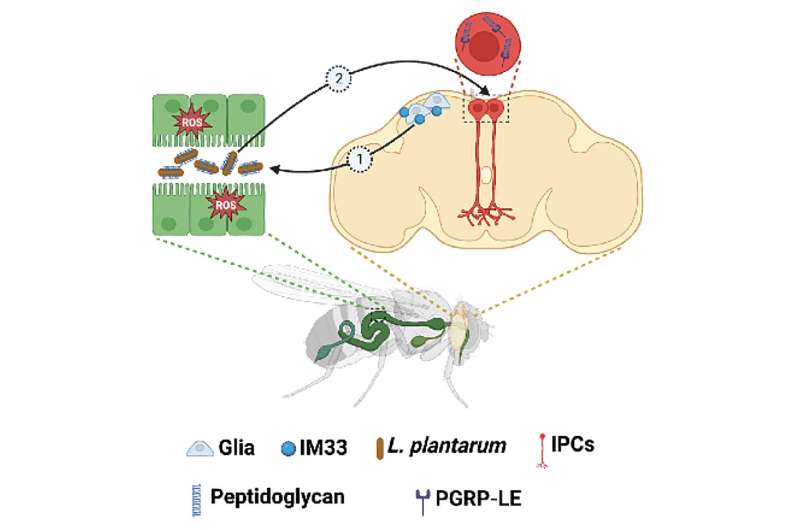November 6, 2023 feature
This article has been reviewed according to Science X's editorial process and policies. Editors have highlighted the following attributes while ensuring the content's credibility:
fact-checked
peer-reviewed publication
trusted source
proofread
An immune molecule that regulates aging and a living organism's lifespan

Aging is a natural process that affects all living organisms, prompting gradual changes in their behavior and abilities. Past studies have highlighted several physiological factors that can contribute to aging, including the body's immune responses, an imbalance between the production of reactive oxygen (i.e., free radicals) and antioxidants, and sleep disturbances.
While the link between aging and these different factors is well-document, the connection between them is still poorly understood. Researchers at Washington University in St. Louis recently identified an immune molecule that could play a key role in modulating the process of aging and the duration living organism's lifespan.
Their paper, published in Neuron, was inspired by two independent research efforts at the university.
"Our previous research identified a gene called Slpi as the top-upregulated gene in the meninges of old mice. Slpi is evolutionarily conserved and has an ortholog named IM33 in Drosophila, prompting us to turn to flies to study its role in aging, leveraging their powerful genetics and short lifespan," Wangchao Xu, one of the researchers who carried out the study, told Medical Xpress.
"Concurrently, inspired by our lab's other findings suggesting that cytokines can shape animal behaviors, I used flies to screen for all immune effectors that can modulate fly behaviors and found that IM33 was a modulator of sleep."
In two of their previous works, Xu and his colleagues identified mechanisms in mice that could be involved in aging and found that cytokines (i.e., proteins that support the immune system and help to manage inflammation in the body) can influence the behavior of animals. Subsequently, the researchers realized that these two distinct physiological phenomena they identified could be connected and set out to explore the possible link between them.

"The study employed multidisciplinary approaches from genetics, neuroscience, immunology, and microbiology," Xu explained. "These approaches included genetic perturbation, behavioral assessment, microbiota manipulation, neuronal activity imaging, and molecular sequencing to investigate the role of IM33 in various aspects of aging."
The researchers used a wide range of experimental technique to examine fruit flies (Drosophila) and mice. They specifically tried to understand the potential role of the protein IM33 and its analog SLPI in mice, in controlling the aging of mice and other mammals.
When the team knocked down this gene in the immune cells of fruit flies, they found that this increased the level of reactive oxygen species and altered the composition of microbiota in their gut. This resulted in oxidative stress and in an imbalance in bacterial composition (i.e., dysbiosis), which in turn reduced their lifespan. The researchers found that knocking down this gene also caused sleep disturbances, which have also been associated with aging and a shorter lifespan.
"This is a proof-of-concept study demonstrating that an evolutionarily conserved immune molecule can serve as a messenger, conveying information between the brain and gut to regulate different levels of aging and control lifespan," Xu said. "This function goes beyond its immune role and further strengthens the contribution of neuroimmune interaction to aging. "
The recent study by Xu and their colleagues is a significant contribution to ongoing efforts aimed at better understanding the neural and genetic underpinnings of aging. In the future, their findings could inform new research exploring the role of the IM33 and SLPI genes, potentially leading to further important discoveries.
"We suggest that peptidoglycan signaling, a conserved immune pathway, in the neuron could be a potentially novel target to slow down aging," Xu added.
"The mechanisms through which the brain secreted IM33 shapes the gut immune environment remain mysterious and warrant further investigation. Moreover, testing the role of meningeal Slpi in mice will help determine whether this is a shared mechanism throughout evolution and provide additional supportive evidence for future translational studies."
More information: Wangchao Xu et al, A novel immune modulator IM33 mediates a glia-gut-neuronal axis that controls lifespan, Neuron (2023). DOI: 10.1016/j.neuron.2023.07.010.
© 2023 Science X Network




















